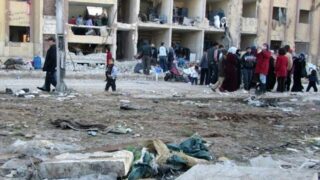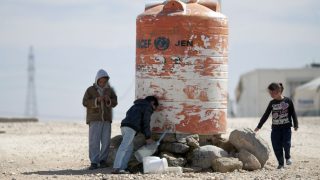
This publication has benefited from the support of the Rosa Luxemburg Foundation. This text may be reproduced in part or in full, provided the source is acknowledged.
The sea storm that hit the coast of Syria last June (2022) left behind a large number of victims and material damages. While it was the only storm that hit Syria that summer, dust storms afterwards raged in the eastern parts of the country in July, their aftermath reaching as far as Damascus and other cities. Although this type of dust storm is quite common in Syria’s inlands, the intensity and timing of this one, reaching provinces as far as Al-Suwayda and Tartus, has raised questions and fears about what’s going on in terms of Syria’s climate and nature.
These conflicting phenomena have entwined with Syria’s exposure to the worst drought in the past seventy years, while the country registered a record low in rainfall in 2021, according to the Syrian Minister of Agriculture, Hassan Qatna, in his statement to the local “Madina” radio (which was broadcast by other radio channels as well). The European Commission described it in a less alarming manner, noting that this was the worst drought that the country has seen in the last quarter of a century. The situation, however, is headed towards a much grimmer and more precarious turning point.
Symptoms of climate change in Syria
Climate change symptoms in Syria haven’t been limited to the odd timing and momentum of storms and rainfall or sea surfs gushing into seashore facilities for the first time, according to the locals’ testimonies. They have surpassed these irregularities to more hazardous and unprecedented rises and drops in temperature in summer and winter.
According to the Meteorological Centre, in July 2022, there was a 5°C rise above the mean annual temperature. Temperature in Al-Hassakah city (in north-eastern Syria) reached 44°C, as compared with 2010, where it reached 33°C in the same month – which is itself two degrees higher than the temperature noted in July 2008. This indicates an accelerating increase in the difference between the annual mean average temperatures. In the coastal Latakia, for instance, known for its agreeable and temperate climate, temperature reached around 40°C this summer.
According to the initial estimate made in 2019 by an expert company in Mediterranean climate change, the rise in temperature in Syria between 1931 and 2008 was estimated at 1°C, whereas the rise between 2008 and 2022 is estimated to be 2°C, if not more. The temperature differences in Syria have been fluctuating beyond what is average, both upward and downward – which indicates uneven climate shifts, moving farther away from the generally temperate Mediterranean temperatures.
The declining rainfall rates, coupled with rising temperatures, lead to drier climate conditions. In the meantime, the previous estimate shows that a 1°C rise in global temperature leads to a 4% decline in rainfall. Between 2008 and 2011, and as a result of rising temperatures, Syria has been exposed to intense droughts, which led to a large rainfall deficit and increased evapotranspiration. Likewise, Syria suffered additional droughts and low rainfall in 2019-2022, with scorching weather conditions and widespread fires.
In parallel to rising temperatures during the summer, the United Nations warned of very rough winters for Syrians, starting in 2021. According to CARE organization, although snowfall and sub-zero temperatures are not unusual in the area, climate changes in the past few years have significantly aggravated the situation.
The fluctuating dry and cold weather has caused damages across the country, the most obvious of which being the drought in Al-Jazirah area (Al-Hassakah, Al-Raqqa, and Deir El-Zor), which makes up a third of Syria’s area and is considered the country’s food basket due to its strategic crops, like wheat, barley, cotton, millions of heads of livestock, and water sources. In the last mid-May report, engineer Mohammed Al-Khathli, director of Raqqa’s Agricultural Department, which is affiliated with Damascus’ government, confirmed that signs of desertification have taken over large areas in Al-Jazirah – as a result of the low rainfall and the dire seasonal situation of these areas throughout 2022. He added that most crops have failed and that a large drop in rainfall has been noted when compared with recent years; he said that “Raqqa city centre has received 80 mm of rainfall last winter, as opposed to 208 mm in the winter of 2019”.
The overpopulation experienced in nearby cities and among impoverished communities who have been stripped, for centuries, of all basic life necessities was one of the catalysts for the 2011 outburst.
In terms of agricultural production, wheat yields clearly show the extent of climate change effects. The production of this Syrian staple food has declined, in a matter of ten years, by around one million tons.
Declining rainfall has affected irrigated agriculture too, where hundreds of cisterns and aboveground and underground reservoirs stopped operating. Coupled with power cuts and the challenging maintenance of pumps, large parts of irrigated agricultural areas thus ended up neglected, which was also the case of areas in Syria, to varying degrees.
Besides drought, and the ensuing displacements, a cruel war has led to an increase in climate pollution and its subsequent symptoms. During eleven years of war, weapons of all kinds were used, light calibre weaponry, bombs, missiles, heavy machines, tanks, and combat aircrafts, of which hundreds exploded in Syrian skies or shelled their powder kegs onto Syrian grounds, destroying entire cities. In some cases, radioactive uranium missile use was even noted. This war, with all its events, has caused long-term shifts in temperature means.
The war has not only destroyed cities and villages, but also devoured the plant cover, contaminated water and soil sources, displaced millions of people from their homes into other areas, affected the Syrian society, and inevitably changed society’s habits for the worse. Many people thus turned to lower-cost heating devices, whereby large forest areas and woodlands would be deforested for quotidian heating and cooking purposes.
Local and global reasons for climate change
In 2020, greenhouse gases have reached new levels in the Earth’s atmosphere (that is, despite a significant halt of human activity due to the coronavirus pandemic), and they maintain their general upsurge. While it was expected that the CO2-emitting countries would be affected, the countries and communities with the least impact on global warming were disproportionately affected or, rather, sometimes even doubly affected due to their dilapidated ecological and sanitary infrastructures. Syria’s role in and share of the global climate change, however, must be examined.
According to the United Nations, “Fossil fuels – coal, oil and gas – are by far the largest contributor to global climate change, accounting for over 75% of global greenhouse gas emissions and nearly 90% of all carbon dioxide emissions. As greenhouse gases blanket the Earth, they trap the sun’s heat.”
Climate Change in Algeria and its Impacts
05-11-2022
This not only causes global warming, but also climate change – whereby global temperatures are now rising at faster rates than ever recorded in history. As time passes, high temperatures result in changing weather patterns and the disruption of normal natural equilibrium, which poses numerous hazards to the planet, its land and waters, and its inhabitants altogether.
Signs of desertification have started to overtake large areas of Al-Jazirah, where rainfall has been minimal, as these areas have experienced aggravated seasonal changes for 2022. Most crops have failed, while a large drop in rainfall has been noted as compared with previous years.
While Syria has a petrol refinery in Homs, and one by the coast of Baniyas, thermal plants that operate on gas and fuel, and other plants that use fossil fuels, its overall contribution to carbon emissions in the planet is considered negligible. According to Country Economy, Carbon emissions in Syria were estimated to be a little over 25 thousand Kg of GtCO2 in 2018; in parallel, the global carbon emissions for that same year were estimated at 53.5 billion tons of GtCO2, according to the UNEP. As such, Syria isn’t considered a real factor in the expanding global climate change.
The low percentage of CO2 emissions in Syria does not, however, spare Syrians its effects. The Homs refinery – built in 1959 – is one of the worst catalysts for environmental pollution. Over the decades, it has caused notable climate effects and become a hotspot for contaminated rains. In the Homs petrol refinery, the average annual rainfall surpasses the annual rainfall in Homs city itself, the reason being that “polluters in mid-air concentrate the surrounding raindrops. What’s more, the refinery’s smokestacks have no elimination filters and, as such, whatever burning petrol produced is directly spewed into the air. Despite building refinement units, the emissions’ rate is high.” (1) Furthermore, the refinery has notably emptied its waste in the El-Assi River and rendered its water unpotable. Despite having a water treatment unit in the chemical petrol refinery as well as refinement filters, its effectiveness remains limited.
The second case of human-driven climate change is linked with the petrol refinery and the thermal plant in Baniyas, both of which are fuel-operated. They were built by the Mediterranean Sea in the 1970s, using techniques that failed to address the management of issues related to carbon-emissions. With soot emitted into the air for four decades, the area of nearby mountain villages, which overlook the refinery and the plant, extending all the way to the concrete factory in Tartus, have become a hotbed for pulmonary and respiratory diseases and have experienced degraded tree agricultural seasons. Here, it must be said that fruit trees, like fig and apricot trees, have been notably disappearing, olive tree diseases have been on the rise, and some local bird breeds have become rare, like partridges. These climate changes have most likely been the result of growing pollution rates in the region. Likewise, the refinery and thermal plant have had their own effects on marine life, like polluting the coastal shores with petrol waste, as happened in 2021, with two thousand tons of fuel leaked from one of the thermal plant’s reservoirs, hitting the shores and reaching Cyprus.
In parallel, although human factors, rooted in growing human activity, cannot be ignored, climate change has become evident in the annual recurrent wildfires in Syria’s forests. In 2020 and 2021, the coast, which is the last bastion of forests in the country, experienced the worst wave of fires. There, the fire consumed more than 9000 hectares of olive groves, orchards, and forest trees. The fire spread into a number of villages, and many of were emptied, following the migration of their inhabitants. The fires also spread all the way into the sea.
With soot emitted into the air for four decades, the area of nearby mountain villages, which overlook the refinery and the plant, extending all the way to the concrete factory in Tartus, have become a hotbed for pulmonary and respiratory diseases and have experienced degraded tree agricultural seasons. Fruit trees, like fig and apricot trees, have been notably disappearing, olive tree diseases have been on the rise, and some local bird breeds have become rare.
Syrians, as one would expect, argued for months over who was behind these fires – whether they were manmade or natural occurrences, especially after the state TV channel broadcast interviews with some people who were arrested for arson in those sites. However, the raging fires all across the Middle East during the entire summer of 2021, and in countries that have advanced fire monitoring systems, like Greece and Turkey, have given weather changes a higher probability than conspiracy theories. The recurrence and timing of the fires, which usually hit right before winter, around October and November when humidity is at its lowest and dryness at its highest, further confirmed the former.
As the Middle East is repeatedly hit by fires, the role of the latters in changing weather patterns is rendered more likely. High temperatures have contributed to starting fires in various areas, like in valleys and mountains, which are supposedly temperate and even cold. Fires can thus be equally perceived as a catalyst for climate change, as they result in exterminating all sorts of botanical and animal life forms. Similarly, the fires in the Mersin area in Turkey that started in early September 2022 pose an escalating risk of their eventually reaching Syria.
Social impacts of climate change
The 2019 winter experienced floods and heavy rainfall in the north-western parts of the country and the coast, which resulted in the destruction of autumn and winter crops, like vegetables, and harmed the internally displaced populations whose tents were damaged, while the roads leading to their campsites were blocked. This extreme weather forced people to spend their money on buying foods that they normally produced themselves. As people become less capable of adapting to low temperatures, winter becomes tougher and more devastating. In Idlib, and due to the severe cold (temperature dropped below zero), people have turned to cutting trees to use for heating, as the government failed to provide any sort of subsidy for any kind of heating.
The following year, in 2020, the country experienced the complete opposite, where there was no rainfall – which resulted in an unprecedented drought. What aggravated matters was the fact that large areas of arable lands were impossible to irrigate, whereas dam and river water levels declined, thus impacting human activity and sustenance. Up till the beginning of this winter, drought has been threatening the lives of twenty million Syrians who face hardships in securing water and food. The World Food Programme estimates that 12.4 million Syrians (the highest number ever recorded in Syria) are now food insecure, which is an increase of 4.5 million as compared with 2021 alone.
The declining rainfall has also inhibited the germination of grass and crops, prompting livestock owners to travel long distances in search for food for their cattle, crossing drylands that had once been bountiful grazelands for decades and centuries, including the Syrian Desert. With the expanding dry patch, rising temperatures during summer, and sharp drops to sub-zero temperatures in winter, hundreds of heads of livestock have perished. This was clearly the case in southern Syria (Al-Suwayda and Daraa), where livestock owners who could no longer afford to feed their cattle had to sell them at low prices.
The 2019 winter saw floods and heavy rainfall in the north-western parts of the country and the coast, which resulted in the destruction of autumn and winter crops, like vegetables, and harmed the internally displaced populations whose tents were damaged, while the roads leading to their campsites were blocked. This extreme weather forced people to spend their money on buying foods that they normally produced themselves.
Drought made potable water even more inaccessible in most Syrian areas – as waters became contaminated, dried up, or repurposed for other objectives than drinking. This is the case in the villages next to Al-Sinn spring, which is one of the most abundant coastal springs. A large number of this village’s inhabitants is currently suffering from thirst, where people are forced to buy five-barrel-capacity water tanks (750 litres) for more than 35 thousand SL (around $8) in order to have drinking water.
In Al-Jazirah area, in the eastern part of the country, the drought has further lowered the Euphrates river levels – which is Syria’s water and food lifeline and reservoir. It has also been affected by the growing number of Turkish dams by the Euphrates springs, and Turkey’s use of Syria’s water share in its domestic projects. Syrian water inflows have dropped to less than half their volume (200 m3/sec as opposed to 500 m3/sec), which has led to transforming large areas into agriculturally neglected lands that have started to show signs of desertification. This has given rise to new climatic phenomena, like the currently ambiguous patterns of human migrations into other areas. Some data from Al-Jazirah area indicate that the number of villages abandoned due to the drought has grown in recent years by no less than one hundred villages, whose number of inhabitants is somewhere between one to five thousand. It’s not unlikely today to find villages in the region with very few inhabitants left, and it is evident that these growing human migrations have been a direct result of climate change and its effects.
Due to droughts and low yield, farmers have been driven away from their lands and agricultural practices into other domains or into leaving the country. In parallel, the increasing number of city dwellers indicates that internal/inter-regional migration is on its way to turn from a latent condition into a common one. For instance, the Central Bureau of Statistics has announced that, this year, the number of Hama’s inhabitants, a mid-sized city in the middle of the country, has reached 673 thousand – as per the latest local elections data – whereas it used to be around half that number in 2018. One cannot explain this number by natural population growth, especially since the city has already lost a number of its inhabitants due to the war. It has, however, compensated for its loss with the incoming migrations.
The declining rainfall has also inhibited the germination of grass and crops, prompting livestock owners to travel long distances in search for food for their cattle, crossing drylands that had once been bountiful grazelands for decades and centuries, including the Syrian Desert.
In terms of agricultural production, wheat yields clearly show the extent of climate effects. In September 2022, Syrian Prime Minister Hussein Arnous stated that the regions run by the Damascus administration produced 520 thousand tons of wheat, whereas Al-Jazirah regions, ruled by the Autonomous Administration of North and East Syria, produced around 400 thousand tons. As such, in a matter of ten years, the production of a staple food in Syria has dropped by about one million tons. In 2010, Syria produced two million tons instead of its usual four million in earlier years. The difference shows the largely diminishing areas of strategic crops and the expansion of arid agricultural lands, although this year, Syria will need more than 2.3 million tons of wheat for local consumption.
Are all Syrians created equal before the (looming) disaster?
While it is true that climate collapse will affect us all, not everyone will be affected in the same manner. The growing effects on low-income, marginalized, rural, and disenfranchised communities, like many Syrian individuals in the countryside and cities, are all elements that feed into further weakening links and deepening existent inequality. Those impacts encompass the shepherds’ capacity to handle their livestock and resist the effects of drought in the Syrian Desert; the limited options available to inhabitants of impoverished and marginalized neighbourhoods in larger cities – Damascus and Aleppo – to deal with the aftermaths – like lack of potable water and housing; all the way to small-scale farmers in the southern, western, and northern parts of Syria – whose food security and only livelihood is being threatened by the most severe drought the area has seen in decades.
In Al-Jazirah area, in the eastern part of the country, the drought has further lowered the Euphrates river levels – which is Syria’s water and food lifeline and reservoir. It has also been affected by the growing number of Turkish dams by the Euphrates springs, and Turkey’s use of Syria’s water share in its domestic projects. Syrian water inflows have dropped to less than half their volume (200 m3/sec as opposed to 500 m3/sec), which has desertified large areas of land.
The voices and needs of the most vulnerable groups have long been ignored by official bodies. Climate change isn’t being addressed at any of its multiple levels, neither as a crisis in the general sense of the word, nor as a crisis of injustice in a country threatened by division.
Official news from Aleppo and its suburbs reveal that there has been a number of cholera infections as a result of drinking contaminated water…
The war, coupled with extensive deforestation across Syria, has ended up reducing forestlands to less than 1% of the country’s area. This has impacted the availability of clean air, which would later affect rainfall and cause a new spike in temperatures and lack of access to potable water. It would also affect neighbouring countries, considering that Syria is one of the greenest countries among those in the region - which would, in turn, exacerbate climate change in the medium term.
All Syrian regions have been at the receiving end of climate change, in the air, water, weather, food, and life. Considering the geographical links between these areas, it is expected that climate anomalies would become irreversible in the future. The dryness of inland rivers and springs, alongside the destruction of the plant cover, will render Syria’s environment desertified – which would mean a growing number of conflicts over resources among these geographies – as has been the case with wheat. Conflicts will redesign the internal migration paths, and will largely affect the country’s stability and its already-threatened national entity.
Internal/inter-regional migration is on its way to turn from a latent into a general condition. For instance, the Central Bureau of Statistics has announced that, this year, the number of Hama city inhabitants, a mid-sized city in the middle of the country, has reached 673 thousand – as per the latest local elections data – whereas it used to be around half that number in 2018.
The reliance of the market economy on agriculture (and industry) since the 1990s, which intensified in various stages, was an adoption of a new economic “philosophy” that was coupled with the complete disregard for the severe and disastrous droughts in northeast Syria between 2005 and 2010. Likewise, no one cared to find solutions for people’s lives, and subsidies were lifted, paving the way to intensive and rapid migrations. Furthermore, the overpopulation experienced in nearby cities and among impoverished communities who have been stripped, for centuries, of all basic life necessities was probably one of the catalysts for the 2011 outburst.
Overall, all of these changes will eventually threaten and violate the rights of millions of Syrians to food, health, security, and housing, especially as no political solution appears on the horizon.
The content of this publication is the sole responsibility of Assafir Al-Arabi and Rosa Luxemburg Foundation cannot accept any liability for it.
Translated from Arabic by Yasmine Haj
Published in Assafir Al-Arabi on 22/09/2022
1- From a conversation that the researcher had with one of the refinery’s engineers, who wishes to remain anonymous.





